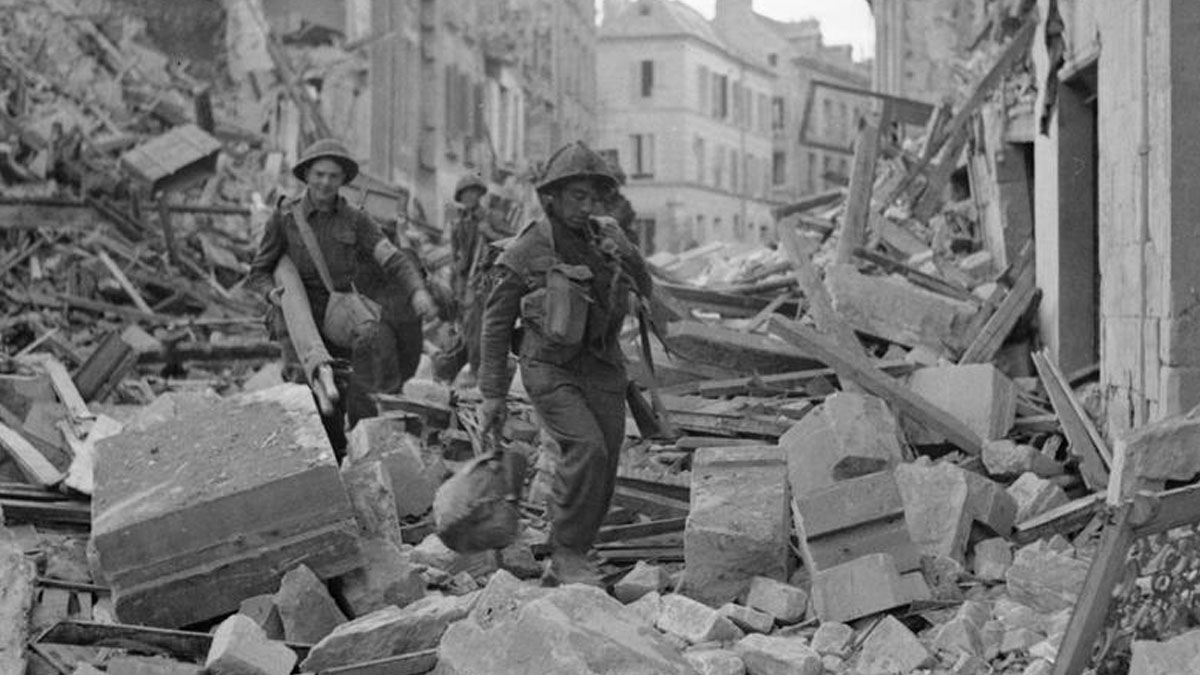On the 70th anniversary of D-Day on 6th June 2014, WartimeNI visited Normandy where we watched the celebrations from Sword Beach and took a walking tour of Caen to see the historic sights of the old city.
My D-Day arrival in Normandy was on board the Mont St Michel of Brittany Ferries. Arriving in Ouistreham Port near Sword Beach at 0645hrs, I was only half an earlier and a few hundred yards away from where troops landed seventy years before. Most who landed near Caen in 1944 were from 3rd Infantry Division and included 2nd Battalion Royal Ulster Rifles.
By 0800hrs in 1944, the British Army had secured the beachhead and had begun the inland advance. They would later rendezvous with 6th Airborne Division at Pegasus Bridge. The centre of Caen was my destination.
Halting the Advances
The 70th anniversary of D-Day commemorations saw many heads of state visit Ouistreham. The port town was the setting for the official international commemoration ceremony. The journey into Caen from Ouistreham came to a stop on several occasions due to roadblocks and heavy security. All public transport was off for the morning.
A walking tour of Caen in 2014
During World War Two, the Battle of Normandy robbed Caen of many of its historic buildings. Much medieval architecture and the university campus received heavy damage during the prolonged bombing of Operation Charnwood. Still, seventy years later, many old buildings dotted around the centre of Caen are worth visiting. Signposts, plaques, and flags tell the stories from William the Conqueror to the liberation of Normandy.
The liberation of Caen came on 9th July 1944 – over a month after D-Day. There are many references to the British and Canadian liberators throughout the streets. The Royal Ulster Rifles, in particular, are held in high esteem. A memorial to the Rifles stands just outside the castle gates.
The Old City
The Place de la Republique stands in the heart of old Caen. It’s there I began my tour. On 7th June 1944, it suffered severe damage under Allied aerial bombardment. This destroyed the old City Hall. The 17th-century French classicist building took several direct hits. Further strikes on 13th June and 7th July caused more devastation. The interior of the hall burned out first but the July strikes rendered it a pile of rubble.
In the years after the war, this area saw much redeveloping and rebuilding. In 1952, the proposed idea of rebuilding City Hall fell through and the council relocated in 1964 to the Abbaye aux Hommes. This public square with its gardens is the starting point for my tour of the town. To the north-west, we leave on Rue Paul Doumer and continue left on Rue de Brasand, and right onto Boulevard Bertrand. Straight ahead is Place Saint-Etienne.
Castles and churches at war
On Place Saint-Etienne stands the Eglise Saint-Etienne and the Abbaye aux Hommes. The abbey, built by William the Conqueror, according to legend once housed the monarch’s remains. During the height of the battle in 1944, residents of Caen would huddle in the church buildings for shelter.
Next, the walking tour of Caen takes us east along Rue Ecuyere, taking a left on Rue Arcisse de Caumont. This street becomes Rue Saint-Pierre, and passes St Saviour’s Church on the way to Place Saint-Pierre. Noticeable buildings here include the 16th century Escoville House. This is now the tourist information office.
Looking to the left is the Chateau de Caen. This castle, built in 1060, belonged to William the Conqueror shortly before his invasion of England. The castle saw action as a military barracks during World War Two and as a result suffered severe damage.
The castle houses the Normandy Museum and the Chapel of St George, which is one of the oldest buildings in the region. The Normandy Museum holds many of the surviving artefacts from the old Arts Museum that once stood in Place de la Republique. Outside the castle walls stands a memorial to the 3rd Infantry Division, who led the liberation charge after D-Day.
After a visit to the castle, we leave to the south along Avenue de la Liberte and turn left on Rue des Chanoines. This takes us towards Trinity Church and the Abbaye aux Dames. In the latter building is the tomb of Matilda, wife of William the Conqueror. Both the men’s and women’s abbeys became temporary hospitals during the fierce fighting of the Battle of Normandy.
A city rebuilt and reborn
From the abbey, we can take Rue Haute to the west. From there, turn left on Rue Manissier, right on Rue Basse, left on Rue Samuel Bochart and right on Rue du Marechal Leclerc. The latter street, of course, named after French war hero Philippe François Marie Leclerc de Hauteclocque. Arriving in Place du Theatre, you will be on the southern side of Place de la Republique.
After the war, the French government erected temporary houses and food stores around this area of town. By 1948, reconstruction began but it would take fourteen years to rebuild the devastated city. This short walk through the old sector of the town unveils an astounding amount of history from the 11th to the 21st centuries. It also shows that many buildings miraculously survived the intense bombing in 1944 and the dedication of the French people to their restoration for our future generations.
This post makes up part of our travel diary from the 70th-anniversary of D-Day in Normandy 2014.
